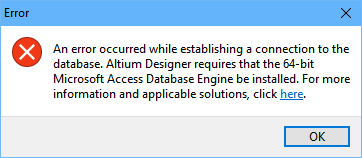Concord Pro and the Library S.M.A.R.T. Rule Part-2
Table of Contents
Altium Concord Pro™ as a standalone product and brand name has been discontinued and the capabilities are now available as part of our Altium enterprise solutions. Learn more here.
Introduction
In the first part of this blog, we saw how you could use Concord Pro® to set up and support the S.M.A.R.T. Rule of Data Management, specifically the Singularity and the Management of your data. Now, we will continue to look at the additional pillars with a bit of a twist to it.
Keep in mind that just like a pillar in a building, these are principles that support what is above it (which we will be looking at later).Since pulling out even one of them may cause others to collapse, each has a distinct purpose in the Design Process.
Although, today is a big day with the introduction and replacement of the name of two pillars. Reviewed (fourth Pillar) will be Reproducible, and the Tailored (The fifth Pillar) will be Traceability. That is a result of conversations with the team at Altium, but also I believe it better describes what’s needed with each of them.
The new 5 pillars - Singularity, Managed, Architecture, Reproducible and Traceability.
Concord Pro and the S.M.A.R.T. Rule Architecture (Third Pillar)
Through Concord Pro, it is a straightforward process to create the architecture you are looking for, with creating your major sections of the component categories and families of subcategories. If you are starting your Data Management system, it is best to look at the major component suppliers such as Octopart and copy their structure. That way, anyone creating a new component can reference them to determine the category and family. Two pre-requisites for creating a Component are first to identify what you are creating by having the Manufacturer Part Number, and secondly to know where it resides in your library, by knowing the category and family.
Concord Pro allows the setup onto a single server which is easily accessible to anyone who needs it. Although we are concentrating on the Component side here, it is not just about components. It is also a resource for just about anything you would need for your PCB design—reusable blocks, various template or Storage area for Projects, preference files, and for your managed projects. We even set up an area of a Resource library of materials like articles, training modules, even videos. It has become popular for anyone wanting to learn new things. Concord Pro is flexible enough to set up any way you want with an easy way to create Folders and sub-folders.
Concord Pro the S.M.A.R.T. Rule Reviewed Reproducible (Fourth Pillar)
We all are familiar with the Review guidelines of using Datasheets and the IPC Standards to verify that the data is correct and usable. But what are we really looking for by reviewing our data? We are looking for reproducible information that can be trusted each time you use it. Once we determine that it is correct, having a verification process in place will allow us to develop a system of reproducibility.
So, with this blog, I am introducing a more in-depth name for the Fourth pillar of Reproducible.
In complex systems with many variables, the reproducibility of results is a bit more complicated. Just ask any baker for example. A baker can follow the same recipe for a loaf of bread, but with varying conditions the results may be different each time. There could be more humidity, or the oven temperature may be off a bit, or it was kneaded it a bit more, and it produced more glutton in the flour which made it chewier. So, each loaf of bread may be different.
But our industry demand reproducibility throughout the entire design process in that way we have the same PCB design at the end with minimal changes. I would label the fabrication and assembly process as a “Complex” system with countless variables in various disciplines of science. But, my experience with Fabrication and assembly houses is they are incredibly controlled environments, which means that most of any issues or problems were initially there from our side. The data we use is the essential step for all of it. We must identify those items that are in our control and not and determine and follow specific guidelines. I will be discussing this principle of Reproducibility in much more details in future blogs.
Concord Pro the S.M.A.R.T. Rule Tailored Traceability (Fifth Pillar)
In the spirit of making further improvements, we are changing the Tailored Pillar to Traceability. What do we mean by traceability as it pertains to a PCB design? Traceability is the ability to verify the history, location, or application of an item using documented recorded identification—being able to trace the data used throughout the process.
This will require a paradigm shift in terms of how you look at the PCB design in general. For many, they feel when they create the Gerbers and send the design packages out that their job is over. But for you, especially in the manufacturing field, your circle of influence needs to be much broader when you get the external reports back from lets DFM or even field service that you can trace that design back to data users and determine if you need to conduct any changes.
I can tell you that traceability is an entire science unto itself. One which we’ll be looking at in more detail in future blogs, with various necessities such as, analysis, requirements, and relationships with different data and how it is controlled to make sure that you do not miss anything and ultimately how you will deal with changes in the data and how it is validated. So, stand by as we dive deeper into this subject.
Conclusion
I have been looking deeper into the S.M.A.R.T. Rule and seeing that the focus is not the pillar themselves but instead what they support. Nothing has changed in the importance of the pillars themselves; they are still highly needed.
But, the pillars support the Components and all the detailed data connected to them, and that is where the underlining principles of the S.M.A.R.T. rule are vital.
Above the components is the PCB Projects themselves. That is the ultimate goal. It is not enough to have a beautiful library if that does not get translated into the PCB designs that we do.
Would you like to find out more about how Altium can help you with your next PCB design? Talk to an expert at Altium and learn more about making design decisions with ease and confidence.





